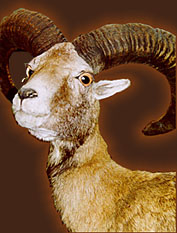
Profile
Mineral Wealth
Marine Life
Habitats
Donations-Collections
Contact
 We
now come to the fourth hall, which is divided in different sections
where the visitor can study the various species of the Cyprus Fauna, their
anatomy and habits, their feeding requirements etc.
We
now come to the fourth hall, which is divided in different sections
where the visitor can study the various species of the Cyprus Fauna, their
anatomy and habits, their feeding requirements etc.
 There
are glass showcases with insects, butterflies, fowl and characteristic
nests of fowl and insects, animal skulls and jaws etc. The collection has
also been enriched with a number of mammals from N. America, which will
be the nucleus of the Museum's foreign exhibits department.
There
are glass showcases with insects, butterflies, fowl and characteristic
nests of fowl and insects, animal skulls and jaws etc. The collection has
also been enriched with a number of mammals from N. America, which will
be the nucleus of the Museum's foreign exhibits department.
Another thing that impresses the visitor is the representation of the Cyprus rural yard with all the domestic animals one could find in the Cyprus yards of the old times.
DOMESTIC ANIMALS

In this section we can see animals that could
be seen in the past in a traditional Cypriot farmyard. Such animals are
donkeys, sheep, goats, cows, rabbits, etc. These aimas have been raised
by Cypriots for centuries and they provided people with provisions which
were indispensable for their survival, such as meat, milk, eggs, skins
and wool.
Indications suggesting that the inhabitants of
Cyprus would raise certain species of domestic animals have existed since
the preistoric era and particularly the 7th millennium B.C., during the
Aceramic-Neolithic Period. Such animals, would have been, for example,
pigs, sheep, goats and donkeys, as well as other species. The ox has also
been used in Cyprus since the Early bronze Age, around 2500 B.C. 
These prehistoric people, who knew the art of navigation, had traversed the sea and came here, bringing with them their household and cattle. It is known that animals, such as goats and sheep, had already been domesticated in the nearby region of the Middle East, during the Mesolithic Era (10,000 - 12,000 B.C.). This Era is the beginning of colonization of the Meditteranean Sea by man.
INSECTS
 We
now come to the Insects Department, where you can see collections of insects
found in Cyprus.
We
now come to the Insects Department, where you can see collections of insects
found in Cyprus.
Insects belong to the Invertebrates and form one of the most numerous groups of animals on Erath, as they can be found in almost every habitat.
Insects play a crucial role in nature although
some of them are considered as harmful to Man. Some feed off other harmful
for Man insects, thus diminishing their uncontrolled proliferation. Insects
themselves constitute a prey to other animals, thus contributing to the
intricate biological balance in Nature.
TOP OF THE PAGE